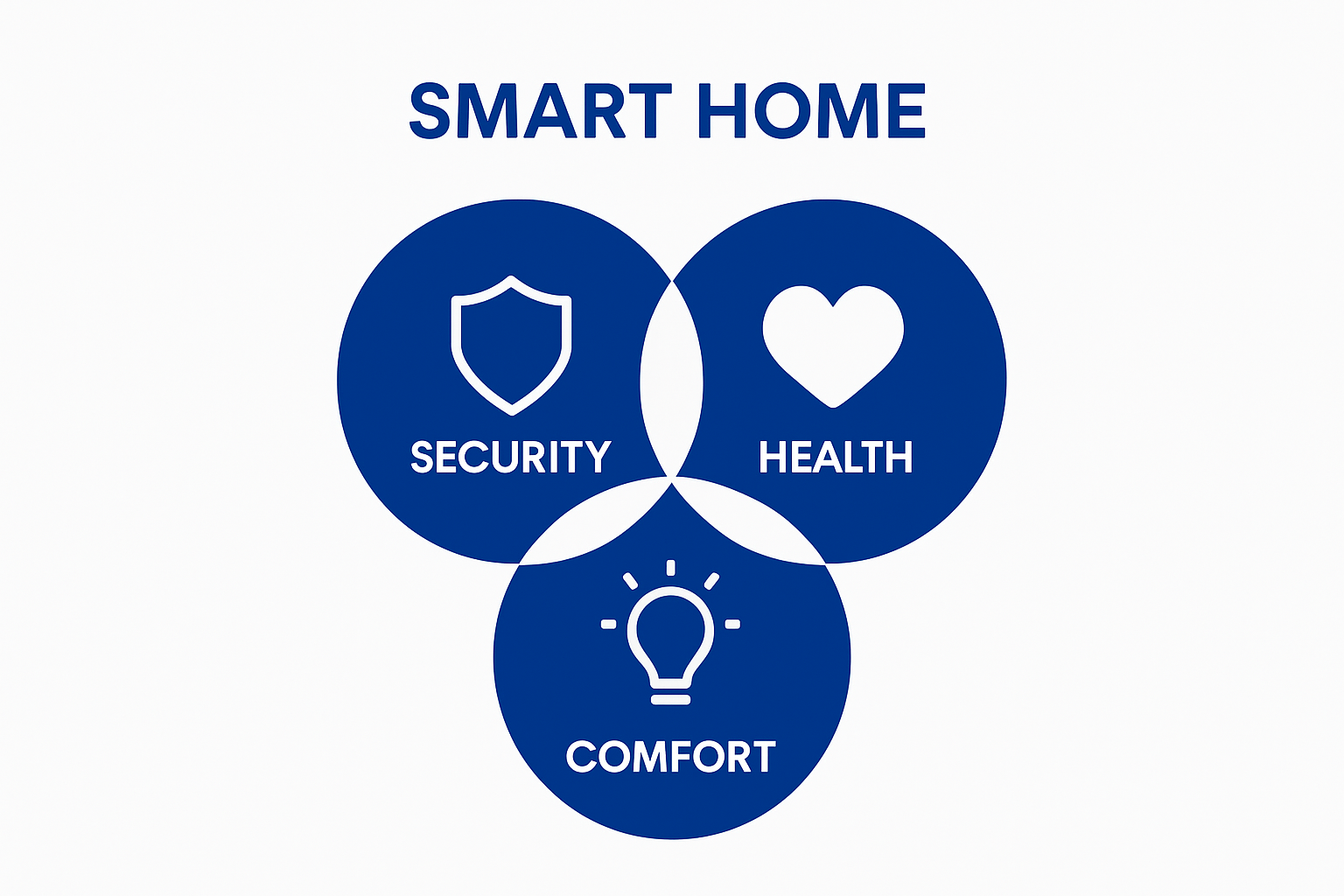
Blog
Understanding the Role of Smart Home Systems | RumahHQ

Smart home systems are turning ordinary houses into intelligent spaces, connecting everything from lights to locks through a central hub. You might expect futuristic gadgetry to be the main draw, yet the biggest impact is often hidden in the numbers. Smart home technology can reduce energy bills by up to 30 percent according to ENERGY STAR guidelines. Many people think it is all about convenience, but the real magic is how these systems help you save money, cut down on hassle, and protect your health in ways few expect.
Table of Contents
Quick Summary
| Takeaway | Explanation |
|---|---|
| Smart homes enhance convenience and efficiency. | Automated systems reduce manual tasks, saving time and effort for homeowners. |
| Health monitoring improves safety for vulnerable individuals. | Smart technologies provide continuous health tracking and alerts, supporting independent living. |
| Energy management systems optimise resource usage. | Intelligent devices adjust energy consumption based on patterns, promoting cost savings and sustainability. |
| Smart home ecosystems adapt over time. | Advanced algorithms learn user preferences, creating a more personalised and efficient living environment. |
| Future trends emphasise integrated, sustainable systems. | Emerging technologies will focus on creating dynamic homes that further enhance user experience while supporting ecological goals. |
What Are Smart Home Systems?
Smart home systems represent a revolutionary approach to residential living, transforming traditional houses into intelligent, interconnected environments. Innovative home technology enables homeowners to manage and control various household functions through digital networks and internet-connected devices.
Core Components of Smart Home Technology
At its fundamental level, a smart home system consists of several key technological components that work together to create a seamless, automated living experience. These systems integrate sensors, wireless communication protocols, and internet-connected devices to enable remote monitoring, control, and automation of home environments.
The primary elements typically include:
- Central Control Hub: A primary device or software platform that connects and coordinates different smart devices
- Internet of Things (IoT) Devices: Sensors, appliances, and gadgets capable of communicating and being controlled remotely
- Wireless Connectivity: Networks like WiFi, Bluetooth, or Zigbee that enable device communication
How Smart Home Systems Function
According to IEEE research, smart home systems operate through a complex network of interconnected devices that communicate and respond to user commands or preset conditions. These systems use advanced algorithms and machine learning to understand user preferences, anticipate needs, and automate routine tasks.
For instance, a smart home system might automatically adjust room temperature based on occupancy, control lighting according to natural daylight levels, or trigger security protocols when unusual movement is detected. The goal is to enhance convenience, energy efficiency, and overall home management through intelligent, responsive technology.
By integrating multiple devices and creating a unified, responsive ecosystem, smart home systems are redefining how Malaysians interact with their living spaces, offering unprecedented levels of comfort, security, and technological sophistication.
The following table organises the core components of smart home systems, providing concise definitions to help readers quickly grasp each element’s role within the technology ecosystem.
| Component | Description |
|---|---|
| Central Control Hub | Main device or software platform that connects and coordinates various smart home devices |
| Internet of Things (IoT) Devices | Sensors, appliances, and gadgets capable of remote communication and control |
| Wireless Connectivity | Network protocols (e.g., WiFi, Bluetooth, Zigbee) that facilitate device communication |
| Sensors | Devices that collect data from the environment (temperature, movement, light, etc.) |
| Actuators | Devices responsible for carrying out actions (switching lights on/off, adjusting blinds) |
| User Interfaces | Applications or panels enabling residents to monitor and control home systems |
Why Smart Home Systems Matter
Smart home systems have emerged as more than just technological novelties. They represent a significant evolution in how Malaysians interact with their living spaces, offering substantial benefits that extend far beyond mere convenience. Explore the latest home technology trends to understand their transformative potential.
Enhanced Quality of Life
The primary significance of smart home systems lies in their ability to dramatically improve daily living experiences. These intelligent systems streamline household management, reduce manual tasks, and create more responsive living environments. Homeowners can now control multiple aspects of their residence through simple smartphone applications, saving time and reducing physical effort.
Key advantages include:
- Personalised Comfort: Automatic temperature and lighting adjustments based on individual preferences
- Time Efficiency: Reduced manual household management tasks
- Stress Reduction: Simplified home control mechanisms
Health and Safety Innovations
According to scientific research, smart home technologies play a crucial role in supporting independent living, particularly for elderly and disabled individuals. These systems enable remote health monitoring, early detection of potential health issues, and enhanced personal safety.
Advanced smart home systems can monitor vital signs, detect unusual movement patterns, automatically alert emergency services, and provide comprehensive health tracking. This technological approach not only improves individual safety but also contributes to more efficient healthcare management.
Beyond personal health monitoring, smart home systems significantly enhance residential security. Integrated security features like automated surveillance, intelligent lock systems, and real-time alerts provide homeowners with unprecedented peace of mind. These technologies create multi-layered security environments that adapt and respond to potential threats more effectively than traditional security methods.
This table compares the main categories of smart home system benefits, highlighting how each aspect enhances homeowners’ quality of life, health, and safety.
| Benefit Category | Key Contribution |
|---|---|
| Enhanced Quality of Life | Personalised comfort, time efficiency, and stress reduction |
| Health Monitoring | Remote vital sign tracking and early detection of health issues |
| Safety and Security | Automated surveillance, intelligent locks, and real-time alerts |
| Energy Management | Automated temperature and lighting control to lower energy consumption |
| Personalised Automation | Systems learn and adapt to user habits, creating a tailored home environment |

How Smart Home Systems Function
Understanding the intricate mechanisms behind smart home systems reveals a sophisticated technological ecosystem designed to enhance residential living. Discover the latest smart home gadgets that power these advanced home environments.
Architecture of Smart Home Technologies
Smart home systems operate through a multilayered technological framework that enables seamless communication and automation. These systems fundamentally consist of three critical layers that work in concert to deliver intelligent home management.
The primary architectural components include:
- Device Layer: Physical sensors, actuators, and smart appliances
- Network Layer: Communication protocols like WiFi, Bluetooth, and Zigbee
- Application Layer: User interfaces and cloud-based management platforms
Data Processing and Intelligent Automation
According to IEEE research, smart home systems leverage advanced data processing techniques to transform raw sensor information into actionable insights. These systems continuously collect data from various home devices, analyze patterns, and make autonomous decisions based on predefined algorithms and machine learning models.
For example, a smart thermostat might track occupancy patterns, temperature preferences, and external weather conditions to automatically adjust home climate. Similarly, security systems can learn typical household movement patterns and instantly detect anomalies, triggering appropriate responses like notifications or alarm activation.
The core intelligence of these systems lies in their ability to learn and adapt. By continuously collecting and analyzing data, smart home technologies become increasingly sophisticated, providing more personalized and efficient home management over time. This adaptive capability ensures that the system evolves alongside the homeowner’s changing lifestyle and preferences.
Key Concepts in Smart Home Technology
Smart home technology represents a complex ecosystem of interconnected devices and intelligent systems designed to transform residential living. Learn about cutting-edge home automation solutions that are revolutionizing modern homes.
Core Technological Foundations
At the heart of smart home technology lie several fundamental principles that enable seamless device communication and intelligent automation. These core concepts provide the framework for creating responsive, efficient living environments that adapt to homeowners’ needs and preferences.
Key technological foundations include:
- Interconnectivity: Ability of devices to communicate and share information
- Automation: Programmed actions that occur without direct human intervention
- Remote Access: Control and monitoring of home systems through mobile devices
Energy Management and Efficiency
According to ENERGY STAR guidelines, smart home technologies play a crucial role in optimizing residential energy consumption. Intelligent systems can monitor, analyze, and adjust energy usage across multiple home functions, delivering significant cost savings and environmental benefits.
Advanced smart home technologies enable precise energy management through sophisticated monitoring mechanisms. Smart thermostats can learn household temperature preferences, automatically adjusting heating and cooling to minimize waste. Motion-sensitive lighting systems ensure electrical resources are used only when necessary, while smart water heaters can analyze usage patterns to reduce unnecessary energy expenditure.
Beyond individual device efficiency, these technologies create a holistic approach to home energy management. By providing real-time insights and predictive analytics, smart home systems empower homeowners to make informed decisions about their energy consumption, ultimately contributing to more sustainable living environments.

Future Trends in Smart Home Systems
The landscape of smart home technology continues to evolve rapidly, promising more sophisticated and integrated living experiences. Explore emerging smart home innovations that are reshaping residential environments.
Advanced Technological Integration
Future smart home systems are moving beyond simple device connectivity towards creating comprehensive, intelligent ecosystems. These emerging technologies aim to provide more seamless, predictive, and personalised home management experiences that anticipate residents’ needs before they arise.
Key technological developments include:
- Edge Computing: Faster, localised data processing directly within home devices
- Artificial Intelligence: More sophisticated machine learning algorithms
- Contextual Awareness: Systems that understand and adapt to complex environmental contexts
Emerging Technological Paradigms
According to academic research in Applied Sciences, smart home systems are increasingly incorporating advanced technologies like 5G telecommunications, which will dramatically enhance system reliability and data transmission speeds. These technological shifts will enable more complex interactions between home devices, creating truly responsive living environments.
The future of smart home technology is not just about adding more devices, but about creating intelligent, intuitive systems that learn and adapt. Imagine homes that can automatically adjust lighting, temperature, and security based on residents’ emotional states, health conditions, and daily routines. These systems will leverage advanced biometric sensors, emotional recognition algorithms, and predictive analytics to create living spaces that are genuinely responsive to human needs.
Moreover, sustainability will be a critical focus. Future smart home systems will integrate renewable energy management, precise resource consumption tracking, and automated efficiency optimisation, transforming homes into dynamic, environmentally conscious living spaces that contribute to broader ecological sustainability goals.
Take the Next Step Towards a Smarter, Safer Home
Smart home systems offer a new level of comfort, efficiency and safety as described in the article. But one common challenge stands out. Many homeowners feel overwhelmed by the complexity of design, technology choices and the need for reliable, professional installation. Malaysians deserve homes that reflect the latest in smart technology and energy efficiency while staying within budget and meeting stringent building standards. If you want to integrate intelligent automation or advanced security into your new build or renovation, the right guidance and professional support make all the difference.

Turn your vision of an intelligent home into reality with RumahHQ. We combine expert residential construction and renovation services with state-of-the-art solutions tailored to the needs highlighted in our article. Our platform is designed to simplify the entire process from quotation to handover with free design consultations and fixed project packages. Discover how easy it can be to create an automated and responsive living space built to last. Secure your smart home upgrade today and see why thousands in Selangor and Kuala Lumpur trust RumahHQ for quality, value and peace of mind. Ready to experience smart living? Visit RumahHQ and start your transformation now.
Frequently Asked Questions
What are the key components of a smart home system?
Smart home systems typically consist of a central control hub, Internet of Things (IoT) devices, and wireless connectivity protocols such as WiFi, Bluetooth, or Zigbee, which work together to create an automated living experience.
How do smart home systems enhance energy efficiency?
Smart home technologies optimize energy consumption by monitoring and adjusting usage across multiple functions, such as automatically regulating heating and cooling based on occupancy and using motion-sensitive lighting to save energy.
Can smart home systems improve personal safety and security?
Yes, smart home systems incorporate integrated security features like automated surveillance, intelligent locks, and real-time alerts, providing homeowners with enhanced safety and peace of mind by adapting to potential threats more effectively than traditional methods.
How do smart home systems learn and adapt to user preferences?
Smart home systems use advanced data processing and machine learning techniques to collect and analyse information from various devices. They continuously learn from user habits and preferences, allowing for personalised automation and more efficient home management.
Recommended
Source link
kontraktor rumah
bina rumah
pinjaman lppsa
pengeluaran kwsp
spesifikasi rumah
rumah batu-bata
pelan rumah
rekabentuk rumah
bina rumah atas tanah sendiri
kontraktor rumah selangor
rumah banglo



